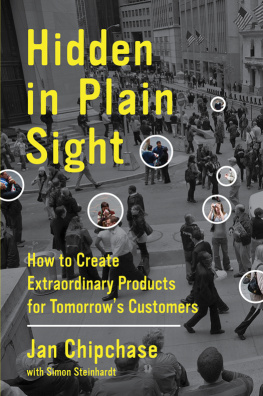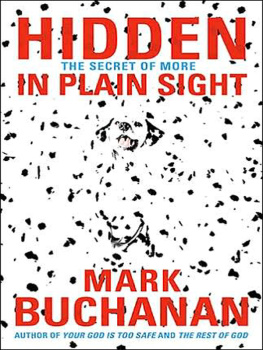
HIDDEN IN PLAIN SIGHT. Copyright 2013 by Jan Chipchase and Simon Steinhardt. All rights reserved under International and Pan-American Copyright Conventions. By payment of the required fees, you have been granted the nonexclusive, nontransferable right to access and read the text of this e-book on-screen. No part of this text may be reproduced, transmitted, downloaded, decompiled, reverse-engineered, or stored in or introduced into any information storage and retrieval system, in any form or by any means, whether electronic or mechanical, now known or hereinafter invented, without the express written permission of HarperCollins e-books.
Grateful acknowledgment is made for permission to reproduce from the following: Excerpt from Portfolios of the Poor by Daryl Collins, Jonathan Morduch, Stuart Rutherford, and Orlanda Ruthven. Copyright 2010 by Princeton University Press. All rights reserved. Reprinted with permission.
FIRST EDITION
Library of Congress Cataloging-in-Publication Data
Chipchase, Jan.
Hidden in plain sight : how to create extraordinary products for tomorrows customers / Jan Chipchase and Simon Steinhardt.First edition.
p. cm.
ISBN 978-0-06-212569-9
1. Marketing research. 2. New products. 3. Consumer behavior. I. Steinhardt, Simon. II. Title.
HF5415.2.C46 2013
658.575dc23
2013003930
EPub Edition April 2013 ISBN 9780062125712
13 14 15 16 17 OV/RRD 10 9 8 7 6 5 4 3 2 1
Contents
You might find my line of work exotic, adventurous, or even a little eccentric, but ultimately Im just trying to figure out what makes people tick.
A large part of my job is to spot and decode the little things that most people take for grantedsomething that many of the worlds most distinguished companies will pay handsomely to understand. The work might have me attending Sunday church services in Utah; walking the aisles of a big-box do-it-yourself store in the Tokyo suburbs; or rising at the crack of dawn to document how a suburban street wakes up and reveals itself to the world.
Other times Im looking to the extremes and to the future, engaging in activities that help me to better understand the outliers that may someday become mainstream behaviors: borrowing money from loan sharks in Malaysia; talking my way out of police detention in a remote Chinese desert; riding two-up on a motorbike through rush-hour Kampala; or walking through some of the more crime-ridden streets of Rio with pockets stuffed full of cash.
Risk, like most things, is relative.
Personally, I think joining a woman on a shoe-shopping expedition in Shanghai is more dangerous than trying to figure out the going rate for a used Kalashnikov in Kabul. Any sign of a camera in the shoe shop and youll be approached by the security staff, wholl assume youre a rival trying to reverse-engineer their store. In Kabul, no one worries about a camera-wielding foreigner; the guns are already assumed to be elegant copies available for sale to all comers.
Yes, my job does have its charms. After a day spent evading guards and sleeping atop a Mayan temple, Ive woken to a stunning dawn above the jungle foliage. Ive strapped my bicycle to the top of a coconut boat and sailed gingerly up the Mosquito Coast. When you love what you do and understand how it might be of value to your well-paying clients, the line between work and play becomes deliberately hazy.
Usually I have a camera with me. These days its a chunky, stripped-down Canon EOS 5D Mark II that has more than earned its high sticker cost, capturing hundreds of thousands of moments for posterity; for analysis; and for teammates, clients, research participants, and others to see. Im not a professional photographer, but you could say Im a professional observer of the ordinary. In most of the places I visit, I spend a lot of time looking at ordinary people using ordinary objects to do ordinary things: making a call on a mobile phone, retrieving cash or a credit card from a wallet, filling up a gas tank from a pump. What I see in these ordinary situationshidden in plain sight from most othersmay be the spark that opens up untapped global markets for my clients. I try to spot opportunities that give clients distinct competitive advantages, whether theyre delivering the most low-tech bar of soap or the most high-tech wireless network. Some of these opportunities are driven by profit motive; others a combination of profit and a desire to help address some of the worlds most pressing social issues: health care, education, and poverty, to name a few.
What I see in all of these situations are the things most of us take for granted: the motivations that drive human behavior. Why, Im constantly asking, are they doing that? And why in that particular way?
The Case for Why
If you want to understand people, you have to understand how people function in the wild, in their natural settings, in a world of chaos and gray areas, a world with consequences, a world thats constantly changing.
I have a great deal of respect for academic researchers who are able to conduct scientifically rigorous experiments with a close eye on how tweaking one or more variables will impact the outcome. Their findings provide a strong foundation for my work (as youll see throughout this book). Through the happy accident of a past life as a poor academic, Ive come to appreciate nontraditional ways of finding an audience, and have found that ultimately its not possible to shoehorn the essence of life into dry academic journal articles.
My workas well as this bookis about scratching beneath the surface to find reality in bits and pieces, and to use those bits and pieces to see the world in a richer, more textured way. In turn, we can use that newfound perspective to forge better relationships, solve some very tricky problems, make more useful and desirable things, and generally better appreciate the world for what it is.
From a business perspective, there are 7 billion (and counting) reasons that necessitate a shift in perspective: the ability to zoom in on finite detailsa train station in Tokyo, a coffee shop in Beirut, a schoolteachers apartment in Kabulin order to get a fix on the big picture. Thanks to the Internet and modern logistics and supply chains, almost anyone in the world could be your customer (or your customers customer), but youll forfeit those opportunities if you dont make the effort to figure out who they are, and the nuances of what they want and why.
Of course, not everyone in the world wants the same things, and certainly not everyone can afford the same things, but youd be surprised at what people can manageand what they desireeven with meager resources. Roughly 80 percent of the world lives on fewer than $10 a day, yet more than half the global populace owns a mobile phone.
Those numbers speak to the purchasing power of the developing world, but they also illustrate how a disruptively compelling technology like the mobile phone can reshape the global market. Youll hear me come back to the mobile phone frequently throughout this book, partly because a significant chunk of my career has been spent working in the communications industry. Primarily, though, its because the mobile phone is the most visible manifestation of one of the biggest disruptors in recent timespersonal and convenient connectivity. It may no longer seem radical, but the ability to reach into ones pocket and retrieve a device that can then reach out to just about anyone, anywhere, anytime, immediately, and with the choice to do so either publicly or privately, has reshaped human interaction across the globe.
Next page











